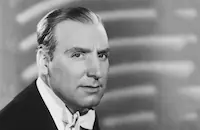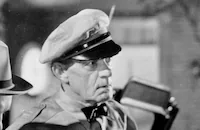Rainbow on the River
Brief Synopsis
Cast & Crew
Kurt Neumann
Bobby Breen
May Robson
Chas. Butterworth
Alan Mowbray
Benita Hume
Film Details
Technical Specs

Synopsis
In 1873, Philip, whose Northern-born father was a casualty of the Civil War and whose Southern mother was a victim of fire, is reared and sheltered in New Orleans by former slave Toinette. Touched by Toinette's devotion to Philip, a gifted singer and banjo player, kindhearted Father Josef traces the boy's surviving family to New York and determines that Mrs. Harriet Ainsworth, a wealthy widow, is his grandmother. Josef writes to Mrs. Ainsworth explaining the situation, but because she hates Southerners and still resents her son for marrying one, Mrs. Ainsworth views Josef's claims with great skepticism. Mrs. Ainsworth's niece, the fortune-hunting Julia Layton, also views Josef's letter with loathing, fearing that with a grandson, Mrs. Ainsworth will cut her and her daughter Lucille out of her will. Despite her reservations, however, Mrs. Ainsworth sends Julia's henpecked husband Ralph to New Orleans to investigate Philip's parentage. Although no documentation of Philip's birth survived the war, Ralph takes a liking to the talented boy and agrees to take him back to New York. Urged by Father Josef to unite Philip with his natural family, Toinette reluctantly parts with her charge, comforted only by the thought that he will have better opportunities in the North. Once in New York, Philip is ignored by Mrs. Ainsworth, who detests Southerners and still has her doubts about Philip's parentage, while Julia and the bratty Lucille plot to have him adopted into another family. Comforted only by his dancing pet mice and by Barrett, Mrs. Ainsworth's gentle butler, Philip leads a lonely existence at his grandmother's and yearns for the warmth of Toinette. Gradually, however, Philip's natural charm and cheeriness warm the heart of his stern grandmother, and a genuine friendship is formed. Philip's budding relationship with Mrs. Ainsworth does not curtail the Laytons' cruelty, however. At her birthday party, Lucille becomes jealous of the attention that Philip's singing and banjo playing attracts and orders another boy to release his mice into a crowd of children. After the ensuing ruckus, Lucille informs Philip that they are sending him to an orphanage the next day and have drowned his mice. Alerted by Barrett, Mrs. Ainsworth finally sees through Julia and Ralph's scheming and stops Philip from running away to New Orleans. Mrs. Ainsworth then takes Philip back to Toinette, who has been pining for her lost child and has become physically debilitated with grief. Moved by Toinette and Philip's intense reunion, Mrs. Ainsworth finally embraces Philip as own her flesh and blood.

Director
Kurt Neumann
Cast
Bobby Breen

May Robson
Chas. Butterworth

Alan Mowbray

Benita Hume

Henry O'neil

Louise Beavers
Marilyn Knowlden
Hall Johnson Choir
Lillian Yarbo
Stymie Beard

Eddie Anderson
Betty Blythe
Theresa Maxwell Conover
Clarence H. Wilson

Lew Kelly
Lillian Harmer
St. Luke's Choristers
Crew
Louis Alter
Johann Sebastian Bach
Hal Bumbaugh
Harry Chandlee
Robert Crandall
Albert Diano
John Bacchus Dykes
Stephen Foster
Charles Gounod
Edward Gross
Karl Hajos
Selma Hautzik
Reginald Heber
Ray Heinz
William Hurlbut
Sol Lesser
Clarence Marks
Abe Meyer
Harry Oliver
Lewis J. Rachmil
Hugo Riesenfeld
Hugo Riesenfeld
Charles Schoenbaum
George Sherman
Earle Snell
Arthur Swanstrom
Paul Webster
Earl Wooden

Film Details
Technical Specs

Quotes
Trivia
Notes
The working title of the film was Toinette's Philip. May Robson onscreen credit was misspelled as "Robeson." According to a Hollywood Reporter news item, Principal borrowed Herman Mankiewicz from M-G-M to write dialogue for this film. Mankiewicz, however, did not receive screen credit nor was he credited as a contributing writer by Screen Achievements Bulletin. According to a letter to Mankiewicz from Principal, his credit was omitted because, in the judgment of Principal executives, only a "minimum part, if any" of the work contributed by him was used in the final script. In August 1936, Hollywood Reporter announced that Principal had offered Edward Everett Horton the comic lead in the picture, but that actor did not appear in the film. Principal borrowed Harry O'Neill from Warner Bros. for this production. Although Hollywood Reporter announced that RKO was borrowing Edith Fellows from Columbia for the production, her participation in the final film has not been confirmed. Lee Prather was announced as both a cast member and a dialogue director, but his participation in the final film has not been confirmed. Hollywood Reporter production charts and news items add Jack Luden, Frank McGlynn, Sr., Robert Strange, Monte Montague, Jesse Clarke and Billy Watson to the cast. Their participation in the final film has not been confirmed. Spencer Charters is also included in Hollywood Reporter production charts, but his participation in the final film is doubtful. Scenes for this film were shot at the Universal Studios "river" lot and in Bakersfield, CA, according to Hollywood Reporter news items. In addition, Hollywood Reporter noted that "recording" of the film began on September 10, 1936 at St. Paul's Cathedral in Los Angeles, where Breen performed with the St. Luke's Choristers.












